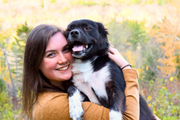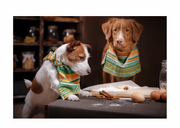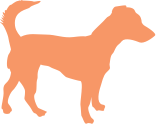SNIFFING, LICKING & CHEWING - 'The Trifecta of Calm'

Let Dogs Sniff
Dogs are social and intelligent creatures who require mental exercise as much as they do physical exercise. So, while you might think that taking your dog on a 60-minute power walk will provide them with all the activity they need, a 20-minute walk at your dog’s pace can actually be just as beneficial and even more enjoyable for your dog!
Sniffing is a natural and highly developed sense in dogs. Every moment your dog explores their environment becomes a captivating scent-laden journey. Sniffing allows your dog to process a wealth of information about their surroundings, including detecting scents that reveal the presence of other animals, food sources, and time. It’s a bit like their version of the internet; providing them with so much information about the environment around them.
We want to make sure our dogs’ lives are as enriched and fulfilled as possible and allowing them to practice their natural behaviours is a huge part of that. Our dogs have incredibly sensitive noses with up to 300 million scent receptors. When you compare this to a human’s 6 million, we start to see why dogs enjoy sniffing so much. That’s why these slower walks, where your dog can “stop and smell the flowers” can be more pleasurable for them as they can glean so much information from a smell and it’s incredibly enriching for them.
Sniffing can also be very calming for your dog. A meandering, sniff session on a long-lead can release the mood-boosting chemical in their brain called dopamine. It’s a lot like a yoga or meditation session for your pup. So, slow down your walk and allow your dog plenty of opportunity and time to sniff. As well as visiting familiar areas, explore different places and mix up the route that you take sometimes. This will give your dog new experiences and of course, new smells to explore.
You can also play enriching, scent-based games with your dog at home, or even buy some dog-safe herbs and plants for them to sniff. Or how about offering your dog a sniffari! Gather up interesting, safe scents and spread them out (this could be done in your living room or garden) and allow them to go from scent station to station at their own pace. Some ideas for them to sniff could be cloths with different scents like lavender, some herbs, an old boot, or some rose petals. Why not see which one your dog spends the longest at!
Another simple and fun game for your dog is scatter feeding. This can be done at any time and all you need is a handful of their favour treats and a grassy area. Simply scatter the treats amongst the grass and allow your dog to sniff it out and gobble it up! Don’t forget to deduct this extra food from your dog’s normal mealtimes so as not to overfeed and always remember to supervise your dog with enrichment so you can help them out if needed!
Lick-a-lot
Licking is a natural instinct in dogs; it is a versatile behaviour that serves many purposes, one of which is to provide dogs with a calming effect. Studies have shown that licking releases endorphins creating a sense of comfort and relaxation. It is much like humans engaging in activities such as meditation or deep breathing to relieve stress. While your dog’s tongue has fewer taste buds than your own, they can still detect savoury, sweet, sour, and bitter. (This is often why your dog can pick out that pill you tried to sneak in their peanut butter.)
From a neurological perspective, licking stimulates the release of neurotransmitters, including serotonin, associated with feelings of well-being and happiness. Additionally, the repetitive and rhythmic licking has a soothing effect on your dog's central nervous system, promoting a state of calm.
Spreading your dog’s raw food over a food-grade surface like a lick mat can help promote relaxation after physical activity or just because! As the weather gets warmer, putting some tasty Beef or Lamb Bone Broth in a freezer-safe dish with a few whole sardines can make an appetising surf and turf pupsicle sure to cool your dog down physically and mentally.
If your dog gets overwhelmed, a lick mat can be a positive distraction. Generally, slow feeders (which lick mats are) help soothe and reduce anxiety as your dog is distracted, their focus is redirected onto something more pleasant.
Choose to Chew
Chewing is an instinctive behaviour deeply rooted in your dog's biology; it isn’t just a phase. Puppies chew to alleviate teething discomfort, while adult dogs often chew to satisfy their natural urge to explore and interact with their environment. This behaviour not only provides physical benefits by keeping their teeth and gums healthy but also has significant mental health advantages.
When dogs chew, it triggers the release of endorphins, which act as natural pain relievers and mood enhancers. The repetitive motion of chewing helps to reduce anxiety and stress by providing your dog with a constructive outlet for their energy. Additionally, chewing is an effective stress management technique.
Neurologically, chewing engages multiple areas of your dog's brain. This mental stimulation not only keeps your dog occupied but also contributes to their overall cognitive development and well-being. Raw meaty bones are a great choice for a natural chew. Have a read of our other blog here, to find out more about the benefits of chewing raw meaty bones.
So remember, sniffing, licking, and chewing are not just simple behaviours; they are integral to your dog's mental health. These activities provide your dog with essential sensory stimulation, promote relaxation, and serve as powerful stress relievers. From a neurological perspective, they trigger the release of neurotransmitters that induce feelings of pleasure, calmness, and happiness. Incorporating opportunities for sniffing, licking, and chewing into your dog's daily routine can contribute to a happier and more fulfilled life.
References:
https://thepetretreat.co.uk/why-are-lick-mats-good-for-dogs/









